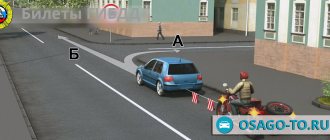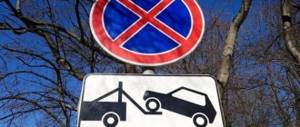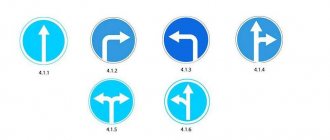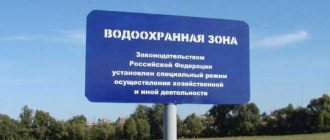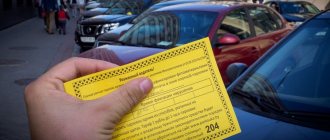Why are parking lot signs needed?
Gaps in legislation regarding the designation of parking spaces have caused all sorts of controversial situations. Paid parking, organized, in fact, illegally, has become increasingly popular. Sometimes rent for a car parked in the courtyard of an apartment building was forcibly collected from the residents of the apartments located in these buildings.
In order to suppress illegally issued parking fines, the term “parking” was established in the traffic rules. To indicate the parking lot, road sign 6.4 was identified, which previously designated a parking space. This step gave rise to new controversial situations, because the parking areas previously designated with such a sign did not correspond to the new definition of parking.
To eliminate the incidents that arose, clause 12.2 of the traffic rules was changed, the new edition of which reflected the possibility of parking a car as follows:
- parallel to the roadway:
- at an angle to the road if there is a sign indicating this type of parking.
Inaccuracies in the legal acts regulating car parking rules gave rise to unauthorized actions on the part of traffic police officers. Thus, for parking in a pocket that is not parallel to the road, the driver was fined 500 rubles. according to Art. 12.19. To systematize legal acts, the term “platform” began to be used.
Our offers
1. Expand sections of the road by 3 meters by shifting the bike path towards the forest.
2. Create a parking pocket along the road, organize parking spaces for vehicles at an angle of 45 degrees to the sidewalk (“herringbone”) with markings in accordance with the 3D plan of the microdistrict site given below.
3. To increase the efficiency of using parking pockets located between houses No. 4, 12, 16 and the Valuevsky forest park, apply markings that determine the rules for the location of cars, in which the number of parking spaces will be maximum.
.
What documents reflect the basic concepts?
To determine whether a driver has violated the Traffic Rules in terms of illegal parking or to protect his interests in court, it is necessary to have an understanding of the basic concepts of parts of highways.
The following documents will help you get acquainted with the concepts:
- Traffic rules in which only “parking” is used among the terms for organizing parking, i.e. a specially designated area intended for paid or free (depending on the owner’s decision) car parking.
- GOST 32846-2014, reflecting the improvement of public roads. According to this document, a parking lot can include not only an organized site, but also an expansion of the roadway intended for:
- transport stops;
- short-term parking at monuments, service stations or other objects.
- GOST R 52289-2019. According to this document, car parking is designated using the sign 8.6.1 “Method of parking.” The presence of a sign indicating the specific method of positioning the vehicle under the sign is mandatory.
Clause 5.7.5 of the specified GOST excludes the designation of parking without such signs. Thus, a sign indicating parking and not having an additional sign indicating the method of parking (8.6.2 - 8.6.9) will be recognized as not complying with the GOST in question. Prosecution for illegal parking on the basis of such a sign will be unlawful and easily contested in court.
- SP 42.13330.2016 – set of rules for urban planning. This document reflects the concept of parking as follows: a site on the roadway or sidewalk, provided with the necessary capacity (number of cars per hour).
- SP 396.1325800.2018 - a set of rules for streets and roads running in populated areas, reflecting, among other things, the width of parking lots. According to this document:
- parking is not allowed on main roads and streets of 1st and 2nd class;
- it is allowed to organize parking on class 3 main streets and district streets in specially designated pockets;
- no restrictions are imposed on parking lots located on city or village streets. Thus, if the pocket is located on a section of a residential or town street, you can park your car without the risk of being held liable.
Arrangement of parking lots in Moscow and the Moscow region
The volume of personal transport used by Russians is growing so quickly that the existing utilities and road infrastructure simply cannot cope with the increasing flow of demands, including the number of parking lots, which are sorely lacking in Moscow and the Moscow region today. Organized sites for the temporary placement of cars, especially in local areas, near enterprises or organizations, do not accommodate all transport and periodically require expansion. But problems can be avoided if, from the very beginning, we rely on modern design solutions and take into account the possible workload of the structure being built or reconstructed. If you already need arrangement or asphalting of a parking lot in Moscow and the Moscow region, just entrust it to real professionals in their field - for whom such tasks are not at all difficult.
Main features and purpose of parking lots
Arranging a parking lot always begins with choosing the right location for it. In particular, we can talk about a completely open or closed (underground) structure. The status of the object matters.
Whether it will be public or intended only for a certain group of people (enterprise employees, house residents, hotel guests), paid or free - all this will ultimately influence the choice of design solution.
It is important to understand that today both the arrangement of underground parking and the implementation of work on the organization of short-term parking areas are regulated by the requirements of building codes and regulations, and must fully comply with all established standards.
If we are talking directly about classic parking spaces, then they should be equipped with the following structures:
- Elements of road markings. Dividing strips and road signs make the process of operating such facilities much more comfortable.
- Landscaping details. To simplify the process of placing cars in designated areas, signal lights and delineators are used. Artificial bumps, noise stripes and ramps are responsible for safety.
- Access control elements. Both access blockers and barriers or chain-type barriers can act in this capacity.
- Equipment that ensures safety and comfort for every visitor. A wide range of elements are used here, the set of which is determined individually.
Can you park in your pocket?
Any pocket on the roadway must be marked with one of the following images:
- Yellow markings 1.17 together with signs indicating stopping places for route vehicles (5.16-5.18). Parking a car under such conditions is unacceptable;
- A “Parking” sign with a sign indicating the specific way to park the car. In such a place, the driver has all legal grounds for parking;
- "No Stopping" sign.
Sometimes, in front of a pocket that is not marked with a sign or markings, there is a 3.2 sign prohibiting stopping in the indicated place. This fact misleads drivers, because in fact the unmarked pocket is not part of the road covered by the sign. But traffic police officers often do not share this point of view and attribute the pocket to the widening of the roadway.
Many sources say that if, along with the “No Stopping” sign, a “Parking” sign is installed, then the latter will have priority. However, there are often cases in which traffic police officers draw up reports on drivers who parked a car in such a controversial place.
If the sign prohibiting stopping is also supported by the “Car Towing” sign, then in order to avoid disputes and fees for impound parking, the driver should look for a more suitable place to park the vehicle.
Is it legal to evacuate from a parking pocket?
First of all, let's look at Table 8.24:
8.24 "The tow truck is working." Indicates that a vehicle is being detained in the coverage area of road signs 3.27 - 3.30.
The essence of the tow truck sign is that it warns the driver about a possible evacuation. In this case, its coverage area completely coincides with the coverage area of sign 3.27.
3.27 "Stopping is prohibited." Stopping and parking of vehicles is prohibited.
The effect of signs 3.10, 3.27 - 3.30 applies only to the side of the road on which they are installed.
That is, sign 3.27 in the example under consideration applies to the right side of the road and is valid until it is canceled.
Thus, no matter what shape the right edge of the roadway has, sign 3.27 continues to be in effect. It also works inside the parking pocket. That is, the car in the specified location can be towed .
If traffic organizers want to allow parking inside a pocket, then a combination of road signs 3.27 and 8.2.3 is installed before the start of the pocket:
Also note that sign 6.4 “Parking” does not indicate that sign 3.27 is no longer in effect:
That is, if first there is a sign 3.27 “no stopping” on the road, and a sign 6.4 “Parking” is installed in front of the parking pocket, then this only means that the situation on the road is controversial. And it’s better to look for another parking place where there is no threat of the car being towed.
If the parking space is not marked in any way
According to traffic regulations, the road is intended for traffic, and the territory adjacent to it is intended for parking, in which, on the contrary, through traffic is prohibited. If the pocket is not marked in any way, it is considered the same as the territory adjacent to the road and allows parking of vehicles.
Clause 12 of the traffic rules indicates the possibility of parking:
- on the side of the road located to the right of the roadway;
- on the edge of the road;
- in exceptional cases on the sidewalk in specially designated places, subject to the presence of an appropriate sign and plate.
However, pocket parking still causes many controversial situations between drivers and inspectors. To prevent such disputes, the legislator should systematize the regulatory framework on the issue under consideration.
Responsibility
Punishment for a violation committed when parking a vehicle is regulated by Article 12.19 of the Administrative Code. Its size directly depends on the type of offense committed:
- Stopping at a widened roadway that is not marked accordingly will result in a fine of 500 rubles. The first time the driver gets off with a warning. If the violation occurs on the streets of St. Petersburg or Moscow, the fine will be 5 times greater (RUB 2,500).
- Parking on a section of road designated for stopping minibuses, buses or taxis will result in a fine of 1,000 rubles for the offender. In this case, residents of Moscow and St. Petersburg will have to pay 3,000 rubles.
If the driver believes that penalties were applied to him illegally, he can appeal the decision made by the traffic police officer. To do this, you need to prepare a sufficient evidence base and learn all the rules and concepts specified in the article.



